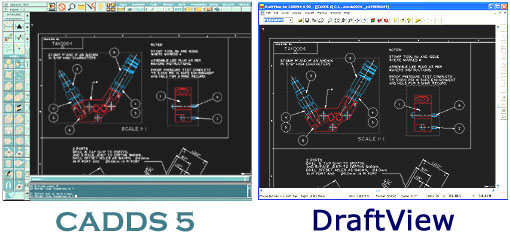
 |
 Access CADDS Designs Directly DraftView is the convenient way to view, print or export CADDS designs. Reading CADDS designs directly has many advantages. For viewing purposes, it eliminates the overhead of storing CADDS drawings as duplicate image files. Direct viewing also provides greater functionality, such as layer and view control. These capabilities are not possible with duplicate non-CAD files, such as CGM, HPGL or raster images. With DraftView you always view the actual CADDS design, eliminating the potential for viewing "stale" image files.
|
|
| Previous 1 2 3 4 5 6 Next | |
 |
|
The Tool For Legacy Data
DraftView was introduced 20 years ago, when Computervision was still the dominant CAD vendor in the industry. With thousands of DraftView installations worldwide, the product has matured according to customer's needs. As a complete CAD system, CADDS itself is a very large program that can be difficult for users to learn. By contrast, DraftView is much easier for the casual user to learn and use. DraftView is also much less expensive than an installation of CADDS. In many cases the solution for legacy CAD data is translation into other CAD systems. DraftView can export CADDS designs using the popular DXF format. DXF exports can be done individually as needed, or in "batch", by the thousands. As a CADDS viewer, DraftView's distinct advantage over other translators is that you can view precisely what is being translated. |
|
| Previous 1 2 3 4 5 6 Next | |
 |
 What You See Is What You Get! Of the few CADDS viewers that exist, DraftView has the most complete viewing capabilities. Other CADDS viewers only display the 3D model, and do not display important information, such as dimensions and text. DraftView displays 3D models and all 2D text, dimensions and Feature Control Symbols. It is the only viewer that can handle all 26 CADDS text fonts, including Kanji fonts. Why use other CADDS viewers that do not display all entities, require a CADDS license, or perform extra "import" steps for viewing? DraftView has none of these restrictions and is the least expensive of them all.
|
|
| Previous 1 2 3 4 5 6 Next | |
 |
|
Comprehensive Viewing Features Specific CADDS Viewing Capabilities: CADDS Output Capabilities: Standard Viewing Features: |
|
| Previous 1 2 3 4 5 6 Next | |
 |
|
Export CADDS To DXF
A small Windows program called "DV4X2DXF" is provided for batch DXF translating. DV4X2DXF can queue thousands of CADDS parts for processing. Depending on file size and complexity, DV4X2DXF can translate a CADDS drawing into DXF in less than 2 seconds, on a 3 Ghz Pentium 4 PC. In most cases the translation time is only about 1 second per CADDS drawing.
| |
| Previous 1 2 3 4 5 6 Next | |
 |
|
Multi-user Support DraftView licenses can be installed on individual Windows PCs, or "floated" from a network server. In either case, the product is easy to install and use. A Unix Workstation version of DraftView is also available for SunOS, Solaris and HPUX (The Unix versions lacks some features found only in the Windows version). Pricing
|
|||||||||||||||||||||||||||||||
| Previous 1 2 3 4 5 6 Next | |||||||||||||||||||||||||||||||